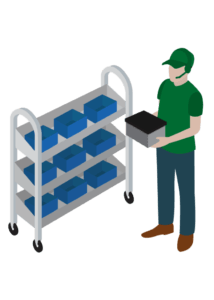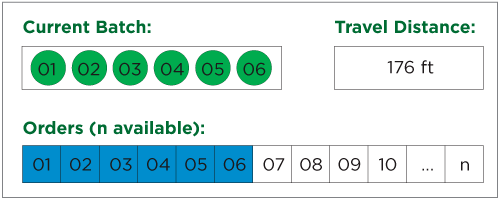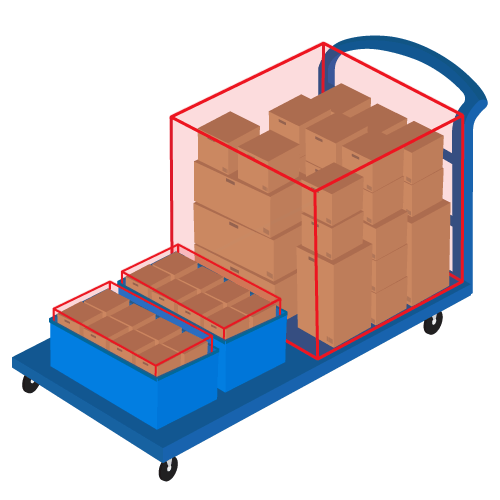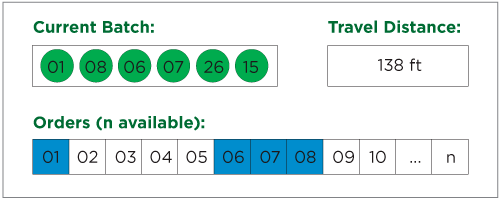Labor is the single largest operating cost in most DCs, and travel often accounts for half of all labor time, especially in order picking. In some DCs, pickers can travel upwards of 12 miles per shift. In order to reduce travel, some warehouses utilize batch picking. However, just like any advanced process, there are multiple ways to batch orders.
This post includes an overview of batch picking, the benefits of batch picking and two different strategies to batch orders – traditional FIFO sequencing and AI-based intelligent batching.
What is Batch Picking?
Batch picking is an alternative to discrete order picking. In discrete order picking, workers pick each order individually on a trip through a DC or zone.
In contrast, batch picking (which is also referred to as cluster picking) is a warehouse order picking strategy in which workers pick multiple orders on each trip through a distribution center or zone within the DC.
Rather than making two discrete trips through a DC to pick two orders, a single picker can pick a batch of two orders on one trip, cutting travel in half.

What Are the Benefits of Batch Picking?
- Reduced Travel: Batching allows for pickers to significantly reduce travel. If 10 orders are batched together, a picker will be able to pass through the pick zone once as opposed to 10 times,
- Increased Productivity: Because workers are spending a significantly less time traveling from pick locations and can pick multiple orders at once, they are much more productive and efficient.
- Reduced Costs from Decreased Labor: Higher productivity rates lead to less overtime and less human-hours picking products. This significantly reduces costs.
- Reduced Fatigue and Crowding: In addition to reduced fatigue, batching can reduce crowding within a pick area, since you need fewer workers to pick the same volume of order.
What Are the Two Different Strategies for Batching Orders?
There are two different methods or strategies for batching. The first (FIFO Batching) is typically done in a warehouse management system. The second method (Intelligent Batching) can be completed in an advanced warehouse execution system.
1) Traditional Batching (First In First Out)
Traditional pick paths will send a picker through a serpentine pick path to pick up all the items for each order.
This strategy is how a a typical warehouse management system will batch orders. The batching algorithms follow a first in, first out sequence (order 1 will be batched with order 2, etc.) without taking travel distance or other factors into account.
Although this method does reduce travel compared to traditional discrete picking (picking a single order at a time), there is a better way to batch orders.
In order to maximize our travel reductions in our batch picking strategy we need to take into account product locations, starting and ending points and the potential travel path.
2) AI-Based Intelligent Batch Picking
The second batching method utilizes AI-based algorithms to make more optimized batches of orders. We refer to this method as “intelligent batching”.
This batching method, performed in an advanced warehouse execution system, uses order, inventory, and location information from WMS and other systems and applies real-time optimization algorithms to create batch assignments. Unlike simple rule-based batching used in a WMS (such as FIFO or product and location overlap), This method considers order priority, pick location, travel cost, product attributes, and other factors to create optimal batches of work.
“Intelligent batching” evaluates millions of potential combinations to determine the “best batch” or grouping of work from among the available orders.
The math behind this is daunting. If 1000 orders are available for batching, and you are trying to create batches of four orders, there are more than 41 million possible combinations. The advanced system runs through the combinations in less than a second as users on the floor request work. DC’s using this method of batching have reduced travel up to 70%, more than doubled picking productivity, and cut labor hours in half. Watch the animation below to learn more.
Distributors Can Cut Travel in Half and Double Productivity With AI-Based Intelligent Batching
If you’re looking for ways to increase productivity in your warehouse or distribution center, consider using batch picking.
As we’ve discussed, batch picking allows warehouse employees to spend more time picking and less time walking. However, warehouse management systems don’t maximize the gains from batch picking.
If you’re interested in maximizing gains you can get from batch picking, consider utilizing advanced warehouse or work execution systems to batch more intelligently. Distributors using this method of batching have more than doubled picking productivity and cut labor hours in half without making any changes to their warehouse layout or adding expensive automation or robotics.
Learn more about our travel optimization module here or if you’d like to get a free travel simulation to see your potential travel savings, send us a message and we’ll be in touch.
Additional Ways to Improve Order Picking Productivity
In addition to improving productivity with batch picking, there are a variety of strategies distributors are using. we’ve compiled a variety of strategies from our warehouse experts and posted them here, “The Ultimate Guide to Improving Warehouse Order Picking Productivity.”





